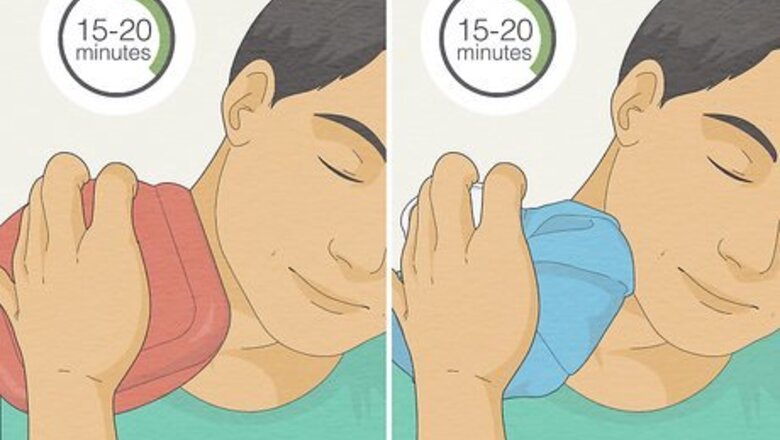
views
- Weak neck muscles contribute to soreness, so stretches and exercises help.
- Relax your neck muscles with heat, massage, or acupuncture.
- Adjust everyday habits in order to prevent constant strain on your neck.
- Consult specialists if you still experience ongoing or severe neck pain.
Finding Immediate Pain Relief
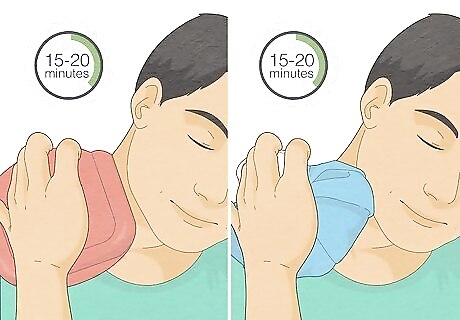
Apply a hot and a cold compress to the sore area. To try “heat and cold” therapy, place a hot compress onto the part of your neck that’s tight and inflamed—leave it on that spot for 15-20 minutes. Then, place an ice pack on the same region for 15-20 minutes as well. Wait 2 hours before repeating another round of heat and cold therapy. Heat brings blood flow to your muscles and relaxes them. A hot compress also helps release nutrients that will heal an injured neck. An ice pack allows you to feel some temporary relief when your muscles are inflamed.
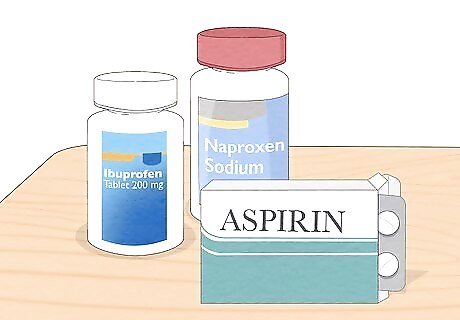
Take OTC pain relievers. To reduce inflammation in your neck, take “nonsteroidal anti-inflammatory drugs” (NSAIDs). Common NSAIDs include ibuprofen, naproxen, aspirin, and celecoxib, which are all available online or over-the-counter at your local drug or grocery store. Follow the dosage instructions of every medication and avoid long-term use if it’s not recommended. Aspirin can treat mild to moderate muscle aches. Ibuprofen is best for mild or moderate inflammation. Naproxen is typically taken if you experience a lot of swelling. Celecoxib can reduce severe pain and stiffness in your neck.

Stretch to relieve tightness in your neck. Alleviate the routine stresses your body goes through with some simple movements that can make a big difference. Throughout your day, take a break and try out positions designed to loosen up your neck muscles. Tuck your chin down: Stretches the back of your neck Tilt your chin upward: Stretches the front of your neck Stretch to the right and left shoulder: Eases tension on either side of your neck Stretch your chest and shoulder muscles: Corrects poor posture and relieves tightness in your neck Stretch your shoulder blades: Relieves more severe neck tension after long periods of immobility
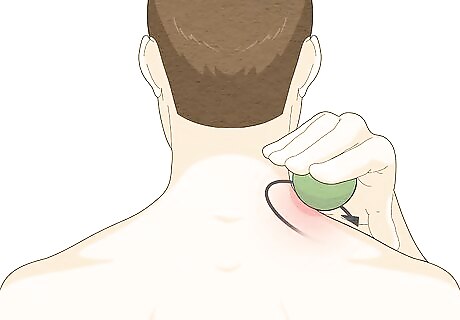
Massage the spots where you feel pain. Perform a “trigger point” massage by identifying all the tight spots on your neck. To find “trigger points,” reach behind you and pinch the muscles in your neck—feel around for knots and spasms. Knots usually feel like tight bumps, while spasms cause your muscles to twitch or pulse. Press firmly and knead these areas of tension for around 3-5 minutes. Repeat 5-6 times a day. When you massage away the tension, press at areas as hard as you like. Alternatively, use foam rollers or massage balls to work out tightness in your neck.

Move around regularly to manage neck pain if you work at a desk. During your work day, minimize any strain you feel in your neck by adjusting your position. Design a routine that you can go through at your desk. Also focus on all the ways you can unstiffen your neck while you sit or type. For example: Shoulder shrug: Raise your shoulders toward your ears to relieve slight tension in your neck. Head glide: Sit upright, lean your head back, and hold for 20 seconds to stretch out your neck. Neck relaxer: To relax your neck, drop your head to the left and touch your ear to your left shoulder, then repeat on the other side. Shoulder roll: To reduce the strain on your neck, roll your shoulders back in a circular motion. Repeat 5 times. Chest stretch: To loosen up your neck, grab the back of your head and squeeze your shoulder blades together.
Preventing Future Neck Pain

Check your posture regularly. Improve your posture to maintain the natural curves of your spine and avoid chronic neck pain. Whether you're standing or sitting, push your chest forward and pull your shoulder blades together. Keep your shoulders relaxed so they move down your back. Then, engage your core, tuck your chin slightly, and raise your head. When you make all these small but important adjustments, you’ll strengthen your neck muscles. Monitor your posture throughout the day, especially if you are sedentary and sit a lot or have a tendency to slouch. It can help to set reminders on your phone every hour.

Create a workspace that supports your posture. To avoid any slouching, which weakens your back and neck muscles, look for a chair with a headrest. If you work at a computer, maintain good posture by adjusting your monitor so it's eye-level—that way, you won't lean forward and stiffen your neck. Sit back throughout the day so you stretch out your neck. Every hour, take a break and move around to loosen up your muscles. All these habits will help you stay healthy and protect your neck throughout a productive day. Since sitting isn’t a very natural position, it can cause a lot of tension in your neck. An ergonomic chair that’s supportive of your neck can offset that, though. If you want a seat that’s ideal for your posture, an exercise ball is a great swap for a chair.
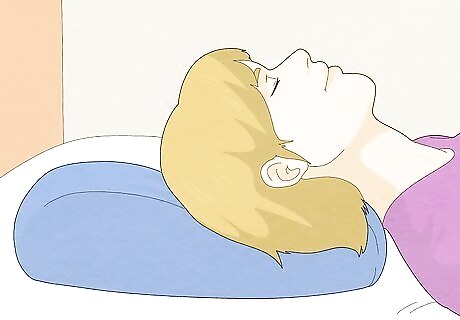
Change your sleeping position. In order to maintain a position that’s natural for your spine and doesn’t lead to pressure on your neck, sleep flat on your back. Also try a long, thin pillow so your neck isn’t raised up in a way that would change the alignment of your spine. Finally, invest in a mattress that equally distributes your weight so your neck and spine stay straight while you sleep, which will boost the chances that you wake up refreshed and pain-free. Avoid sleeping on your stomach since you won’t have enough support for your neck. As an alternative to a thin pillow, try a memory foam or water pillow that molds to the shape of your head and neck. If you’re a side sleeper, you can place a pillow between your legs to keep your spine in alignment.

Change the way you use your phone. Since your phone can cause you to lean to the side to talk or crane forward while you scroll through content, make adjustments to avoid straining your neck. If you spend a lot of time on phone calls, try using earbuds or speakerphone. If you love apps or texting, hold your phone up in front of you so you don’t slouch. Be sure to take plenty of breaks from your phone. Every 20-30 minutes, aim to set it down so you don't put too much strain on your spine and neck. Stretch your neck after a long session of looking down at your phone.

Stay well hydrated. Since the discs in your spine require water to maintain space between your vertebrae, remember to drink plenty of it. To make getting enough fluids part of your routine, drink a glass of water as soon as you wake up. Also carry a water bottle with you and aim to drink 8 fluid ounces (240 ml) 8 times a day. Staying hydrated helps your spine stay in proper alignment, and slows down the degeneration of your discs as you age.

Make sure you get enough magnesium. Since magnesium is a mineral that helps you relax your muscles, stock up on magnesium-rich foods like spinach, pumpkin seeds, and yogurt. For an extra boost, add magnesium supplements to your regimen. To absorb even more magnesium, add Epsom salt—magnesium sulfate—to your bath or give yourself a massage with magnesium chloride oil. If you’re chronically low on magnesium, you are more likely to experience muscle strain.
Seeking Treatment from Specialists
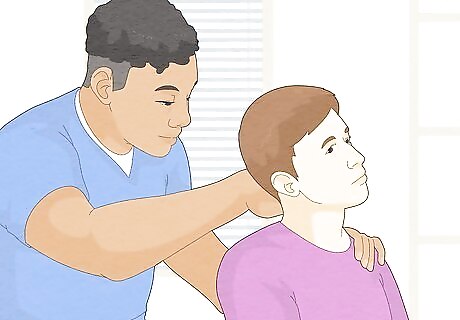
Visit a physical therapist. Ask your physician for a reference or browse your country’s online directory of physical therapists. Then, book an appointment. Let your PT examine your body and evaluate your movements to determine the source of your neck pain. Listen to your PT’s recommendations, which will likely include a series of exercises to strengthen your neck muscles and correct movements that led to chronic neck tension.
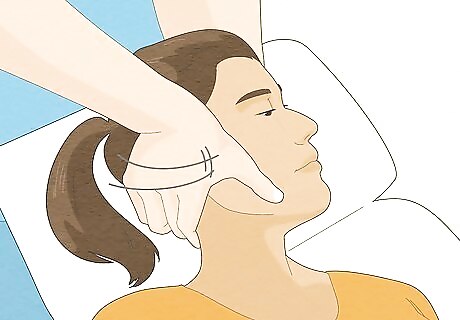
Make an appointment with a chiropractor. See if your doctor can send you to a specific chiropractor or look through a local directory of board-certified chiropractors. When you arrive for your appointment, answer your chiropractor’s questions about your everyday activities. Once they perform a series of exams to check your posture, range of motion, and general health, they’ll be able to create a program of care that includes neck adjustments and rehabilitative exercises. Your chiropractor will also run neurological exams, too. For example, they’ll check your reflexes and strength as well as look for any potential nerve damage to diagnose how advanced your neck pain is.
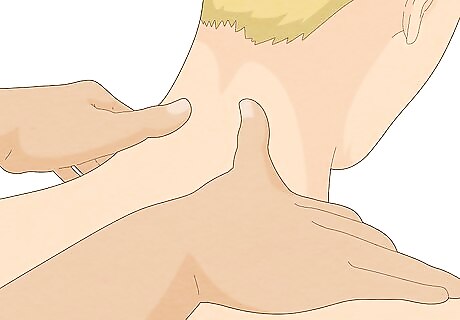
Book a session with a masseuse. Make sure that you hire a certified massage therapist since they'll be knowledgeable about musculoskeletal issues. Ask for either Swedish massage so your masseuse can rub away tension from everyday activities or a deep tissue massage if you need them to knead deeper connective tissue related to chronic neck pain.

Try acupuncture. Ask your physician to refer you to a qualified acupuncturist or search a directory of licensed professionals who are board-certified. After you book an appointment and show up, an acupuncturist will use practices from traditional Chinese medicine. Lay back while they insert thin needles into specific pressure points on your body to stimulate and relax your muscles. A German study found that all 1,400 participants who opted for acupuncture as a form of care for neck pain experienced greater relief after their sessions.

Ask your doctor for medical help if you have chronic neck pain. If you've tried multiple home remedies or forms of treatment but your neck issues have stayed the same or worsened, consult a physician. Let them know if you've experienced pain that goes down from your neck to your arms and legs. If you've noticed weakness, numbness, or tingling, tell them this, too. Explain how long you've experienced soreness or tension—if it's been several weeks, your doctor may recommend surgical or non-surgical options. Non-surgical approaches: prescription medications like muscle relaxants or spinal injections can relieve nerve or muscle pain. Surgical approaches: Cervical spine surgery can remove a damaged disc that's responsible for extreme tension in your neck. Even if cervical spine surgery is called for, most patients usually experience a quick recovery and can go back to everyday activities really soon.















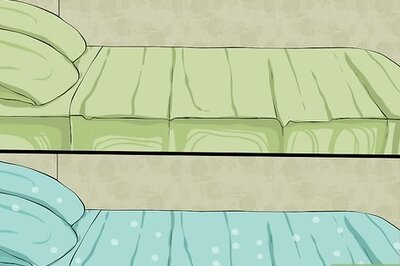




Comments
0 comment